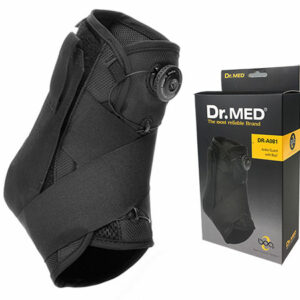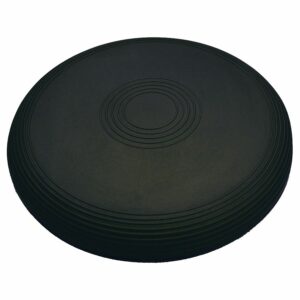Tarsal Coalition
Updated:
What is tarsal coalition?
Tarsal Coalition is a condition characterized by congenital fusion of 2 or more rear foot bones known as the tarsals (figure 1).
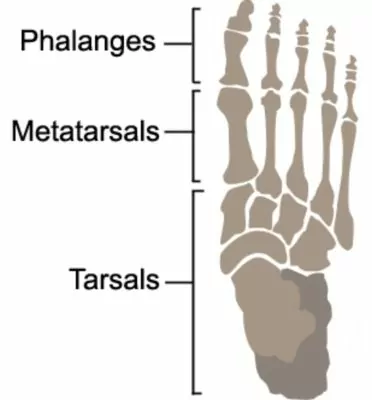
The rear foot comprises of 7 bones collectively known as the tarsals. The mid foot comprises of 5 long bones known as the metatarsals. The toes each comprise of several small bones known as the phalanges (figure 1). Each bone within the foot attaches to the adjacent bones forming joints. Each of these joints allow movement to take place and absorb stress associated with weight bearing activity and general movement.
Occasionally two or more tarsal bones may fuse together and become interconnected. This is usually a congenital abnormality that is present from birth and is relatively uncommon. This condition is known as Tarsal Coalition.
Tarsal coalition in itself is not a painful condition. However due to altered biomechanics and reduced shock absorption associated with the fused bones, increased stress may be placed on this or other areas of the foot and lower limb during weight bearing activity. This may result in pain and injury and is particularly common in adolescents who suddenly increase their activity levels or begin sports participation. Tarsal coalition may also increase the likelihood of adults developing painful bony spurs at sites away from the fused bones.
Cause of tarsal coalition
Tarsal coalition is a congenital abnormality that is present in a small percentage of the population from birth. There is often a family history of the condition and it may occur in both feet.
Signs and symptoms of tarsal coalition
Patients with this condition are usually completely asymptomatic. However, due to abnormal biomechanics and reduced shock absorption associated with this condition, the affected region or other structures within the foot and lower limb may be subject to additional stress and potential injury as a result of the bony fusion.
Symptoms associated with tarsal coalition are more likely to develop following a sudden increase in weight bearing or sporting activity and typically present as mid-foot or rear-foot pain or stiffness or occasionally as a sprained ankle that does not settle. Weight-bearing exercise involving activity over rough ground, jumping or twisting and turning may be particularly aggravating. The pain may be associated with a limp. Rest from weight-bearing activity usually relieves symptoms. On examination there is usually stiffness present in the rear or mid-foot and abnormal biomechanics are usually evident.
Adults with this condition sometimes experience pain and bony spurs in other regions of the foot which may be associated with this condition. In the young athlete a tarsal coalition may first present as an acute ankle sprain or as a history of repeated ankle sprains.
Diagnosis of tarsal coalition
A thorough subjective and objective examination from a physiotherapist or doctor is important to assist with diagnosis of tarsal coalition. An X-ray is usually required to confirm diagnosis. Investigations such as an MRI, bone scan or CT scan may be required in some cases to confirm diagnosis and rule out other injuries (particularly fractures).
Treatment for tarsal coalition
Most patients with symptoms associated with tarsal coalition make a good recovery with appropriate physiotherapy. One of the key components of treatment is that the patient rests sufficiently from ANY activity that increases their pain until they are symptom free (crutches, orthotics, protective taping or bracing may be required).
Rest from aggravating activities ensures the body can begin the healing process in the absence of further tissue damage. Once the patient can perform these activities pain free, a gradual return to these activities is indicated provided there is no increase in symptoms.
Treatment in the first 48 – 72 hours of injury is vital to reduce bleeding, swelling and inflammation. This should involve following the R.I.C.E regime which comprises of rest from aggravating activities (crutches are often required), regular icing, the use of a compression bandage and elevation of the affected limb. Anti-inflammatory medication may also be useful in this initial phase of injury and can hasten the healing process by reducing the pain and swelling associated with inflammation.
It is also important for patients with tarsal coalition to perform range of movement, strengthening and balance exercises early in the rehabilitation process to prevent stiffness and weakness from developing and to ensure the foot and ankle are functioning correctly. These exercises should generally be implemented as soon as pain allows and should be guided by the treating physiotherapist. A gradual return to activity should occur once the patient is pain-free, provided symptoms do not increase.
In some cases orthotics may be required as part of treatment and symptom prevention.
Prognosis of tarsal coalition
Many patients with this condition experience little or no symptoms. Most patients who develop pain due to abnormal biomechanics associated with their bony fusion settle well with appropriate physiotherapy. Return to activity or sport can usually take place in a number of days to weeks. Patients with more severe injuries or who require other intervention (such as surgery) will require a longer period of rehabilitation to gain optimum function.
Physiotherapy for tarsal coalition
Physiotherapy for patients with symptomatic tarsal coalition can hasten the healing process, ensure an optimal outcome and reduce the likelihood of symptom recurrence. Treatment may comprise:
- soft tissue massage
- electrotherapy (e.g. ultrasound)
- anti-inflammatory advice
- joint mobilization
- the use of crutches
- orthotics
- footwear advice
- protective taping
- the use of a brace
- ice or heat treatment
- exercises to improve flexibility, strength and balance
- education
- activity modification advice
- a graduated return to activity program
Other intervention for tarsal coalition
Despite appropriate physiotherapy management, a small percentage of patients with this condition do not improve adequately and require other intervention. When this occurs the treating physiotherapist or doctor can advise on the best course of management. This may involve further investigation such as an X-ray, CT scan, bone scan or MRI, pharmaceutical intervention, corticosteroid injection or a review by a specialist who can advise on any procedures that may be appropriate to improve the condition.
Surgery should be considered in those cases where the patient continues to suffers ongoing pain or ankle sprains and where conservative management has failed. Surgery may involve excision of the bony fusion between the 2 bones. Following this, the patient is rested in a cast for a few weeks, followed by weight bearing restrictions for a number of weeks and a gradual, progressive rehabilitation program.
A review with a podiatrist for the prescription of orthotics may sometimes be indicated.
Exercises for tarsal coalition
The following exercises are commonly prescribed to patients with this condition. You should discuss the suitability of these exercises with your physiotherapist prior to beginning them. Generally, they should be performed 3 times daily and only provided they do not cause or increase symptoms.
Foot and ankle up and down
Move your foot and ankle up and down as far as possible and comfortable without pain (figure 2). Repeat 10 times.
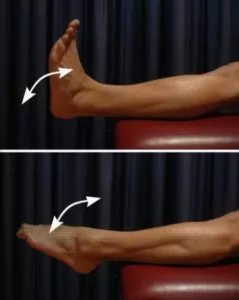
Foot and ankle in and out
Move your foot and ankle in and out as far as possible and comfortable without pain (figure 3). Repeat 10 times.
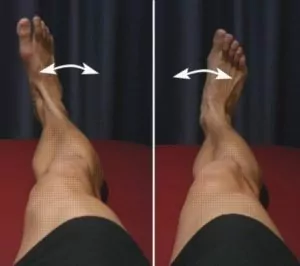
Physiotherapy products for tarsal coalition
Some of the most commonly recommended products by physiotherapists to hasten healing and speed recovery in patients with symptoms from this condition include:
To purchase physiotherapy products for tarsal coalition click on one of the above links or visit the PhysioAdvisor Shop.
More Information
- View more Foot & Ankle Stretches.
- View Foot & Ankle Strengthening Exercises.
- View Balance Exercises.
- View Arch Support Taping Techniques
Find a Physio for tarsal coalition
Find a physiotherapist in your local area who can treat tarsal coalition.

Link to this Page
If you would like to link to this article on your website, simply copy the code below and add it to your page:
<a href="https://physioadvisor.com.au/injuries/foot/tarsal-coalition”>Tarsal Coalition – PhysioAdvisor.com</a><br/>PhysioAdvisor offers detailed physiotherapy information on Tarsal Coalition including causes, symptoms, diagnosis, treatment, exercises, physiotherapy products and more...
Return to the top of Tarsal Coalition.

